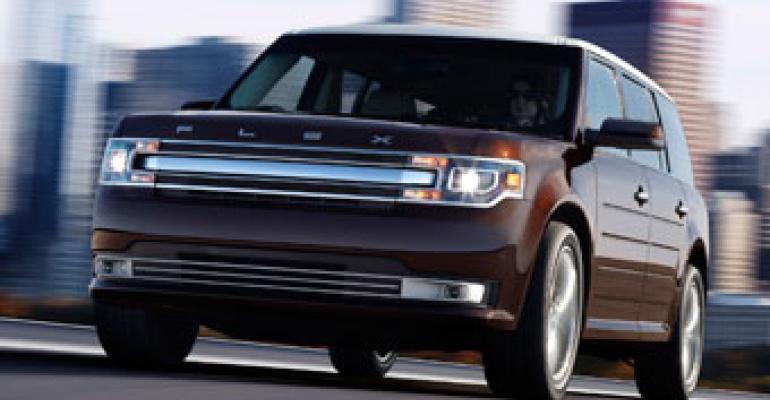
DEARBORN, MI – Ford further accentuates the Flex cross/utility vehicle’s polarizing look with ’13-model design tweaks top executives predict will enhance its unique appeal.
The brazenly boxy Flex, set to debut in refreshed form at next week’s Los Angeles auto show, benefits from a number of design changes, the most dramatic of which are seen from the front. A single chrome bar in the center of the grille replaces the previous-generation’s 3-bar configuration.
And there is no Blue Oval. The badge that adorns the faces of most Ford vehicles is replaced by the Flex name spelled out in large letters along the hood’s leading edge.

“Design is becoming more and more a differentiator across the industry,” says Mark Fields, Ford president-The Americas. And it’s no coincidence Ford is unveiling the ’13 Flex in L.A.
“The West Coast is where design trends start, and they like to make statements,” Fields tells WardsAuto at a media event here. “Flex is very popular in California and it’s helping change our image there.”
Ford says the Flex accounts for one-fifth of all its retail sales in the Golden State.
Other ’13-model design changes include new headlamps, a standard dual exhaust and available rear appliqué.
The Flex also gets Ford’s patented inflatable rear-seat belts, currently offered only on the Explorer SUV. The optional belts have proven popular on the Explorer, with a 33% take rate, Ford says.
Under the hood, the ’13 Flex comes with standard with a 3.5L V-6, the same engine as the previous generation. However, the addition of twin independent variable camshaft timing produces 285 hp – about 20 hp more than the previous engine – and 255 lb.-ft. (346 Nm) of torque.
The Flex with the 3.5L V-6 also is projected to deliver improved fuel economy compared with the outgoing model. Projected city/highway ratings are 18-25 mpg (13 L-9.4 L/100 km).
An optional 3.5L direct-injected turbocharged EcoBoost engine produces 355 hp and 350 lb.-ft. (475 Nm) of torque.
Both engines are mated to a 6-speed automatic transmission that can be operated manually via paddle shifters. Unlike some competitive systems, Ford says the manual mode won’t “second-guess” the driver with an override shift when RPMs increase.
Inside, the Flex gets redesigned instrument clusters, steering wheel and electronic finish panels, as well as new seat trim.
The new Flex also is one of three ’13 vehicles that will mark the debut of Ford’s upgraded MyFord Touch infotainment system. Criticized for being confusing to operate, the auto maker says the system will feature simpler graphics, faster touch-screen response and easier-to-use controls.
“We think we’re taking it to the next level and really giving customers what they really want,” Fields says. Fields says Ford is pleased with the Flex’s performance, despite lackluster sales that have spurred some analysts to suggest the auto maker drop the model from its lineup.
Through October, Flex deliveries stood at 23,012, a 21.9% drop from year-ago, according to WardsAuto data.
“We are really happy with the role Flex plays in our lineup,” Fields says. “Flex is positioned as a 7-passenger CUV, but it’s for customers not looking for off-road capability, but rather to handle day-to-day chores with a real sense of style.”




